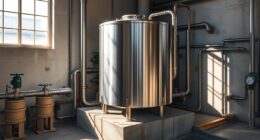In order to perfect the art of flawless tanning, it is important to first assess your skin type to choose the appropriate products. Prepare your skin by exfoliating and moisturizing, avoiding heavy lotions that may result in uneven patches. Utilize a suitable tanning method by selecting the right tanning bed and gradually increasing your session duration. Always remember to apply a broad-spectrum SPF to safeguard your skin from harmful UV rays. Monitor how your skin responds and make adjustments as necessary. Lastly, maintain your tan by using gentle cleansers and staying hydrated. For smooth, long-lasting results, there is always more to learn about refining your tanning routine and techniques.
Key Takeaways
- Assess your skin type to choose the right tanning products and techniques for optimal results.
- Properly prepare your skin by exfoliating and moisturizing to ensure even application and long-lasting color.
- Start with shorter tanning sessions and gradually increase duration to prevent overexposure and skin damage.
- Always apply broad-spectrum SPF and protective gear to shield your skin from harmful UV rays.
Understanding Skin Type
To achieve a flawless tan, you need to assess your skin type, as this will help you choose the right tanning products for your unique complexion.
If you have normal skin, you can experiment with various lotions that contain clear DHA and natural bronzers for a deeper, lasting color.
For fair skin, opt for light, cool bronzers to avoid an orange look, while medium tones should reach for warm, golden shades.
If your skin is deep-toned, rich bronzers with hints of red or orange will enhance your glow.
Preparing Your Skin
Preparing your skin properly sets the foundation for a flawless tan, guaranteeing even application and long-lasting color.
Start by exfoliating to remove dead skin cells, which helps prevent patchiness. Use a gentle scrub or exfoliating mitt to prep your skin thoroughly.
Next, hydrate with a nourishing lotion, like Supre Tan Candy Toasted Coconut, featuring ingredients such as Sugar Cane and Sweet Almond Oil for ideal moisture retention.
Avoid heavy lotions or oils before tanning, as they can create barriers. If you're using a bronzer, make sure it has clear DHA for better development.
Tanning Techniques

Achieving a flawless tan also hinges on understanding the right techniques and timing for your tanning sessions. Start by selecting the appropriate tanning bed based on your skin type and desired results. Traditional beds offer a classic tan, while high-pressure beds provide deeper color.
Time your sessions wisely; begin with shorter durations and gradually increase as your skin adapts. Use a timer to prevent overexposure. Incorporate natural bronzers to enhance your tan's development, but remember to balance UV exposure with skin health.
Always pay attention to your skin's reaction, and if you notice any signs of overexposure, take a break. Following these techniques will help you achieve that golden glow while keeping your skin safe and healthy.
Protective Measures
Wearing protective gear is essential for safeguarding your skin while tanning and ensuring a flawless, healthy glow.
Start with a broad-spectrum SPF suited to your skin type; this helps prevent sunburn and skin damage.
Don't forget stylish sunglasses with UVA/UVB protection to shield your eyes, and a wide-brimmed hat to cover your face and neck. These accessories not only provide protection but also enhance your tanning experience.
Apply a hydrating SPF lip balm to keep your lips moisturized and safe from the sun's rays.
Regularly reapply your sunscreen every two hours, especially if you're sweating or swimming.
Monitoring Skin Condition

Monitoring your skin condition during tanning sessions is essential to prevent overexposure and maintain a healthy glow.
Keep an eye out for signs of redness, heat, or discomfort; these indicate that your skin needs a break. If you feel tingles or itchiness, stop tanning immediately and cool your skin down.
Dryness is another red flag, signaling that you may need to hydrate more or take a longer break. Always listen to your body—if you experience dizziness or other discomfort, seek shade right away.
Choosing the Right Products
Selecting the right tanning products is essential for enhancing your skin's natural radiance and achieving a flawless tan.
Start by evaluating your skin type; normal skin can handle various lotions, while fair skin benefits from light bronzers.
Look for products with clear DHA for a lasting effect, and choose bronzers based on your skin tone—creamy for ease or powder for a more defined look.
Consider healthy tanning alternatives like sunless tanners and spray tans that provide instant color without sun exposure.
Always prioritize ingredients that nourish your skin, such as antioxidants and natural oils.
Ultimately, the right products can make a significant difference in achieving that perfect, sun-kissed glow while maintaining skin health.
Post-Tan Care

How can you guarantee your tan lasts longer and looks vibrant? Post-tan care is essential!
Start by hydrating your skin daily with a quality moisturizer to lock in that beautiful color. Look for products with Cocoa Complex or Sweet Almond Oil to keep your skin soft and supple.
Avoid long, hot showers and harsh soaps, as they can strip your tan. Instead, use gentle cleansers and lukewarm water.
Exfoliate sparingly; too much can fade your tan quicker. To maintain that glow, consider applying a gradual tanning lotion once a week.
Finally, protect your skin from sun exposure with sunscreen, ensuring your tan stays radiant while keeping your skin healthy.
Follow these steps, and enjoy your stunning tan!
Safety Tips and Best Practices
When tanning, always prioritize safety by using appropriate protective gear and adhering to recommended exposure times. This guarantees you enjoy a beautiful, safe tan without compromising your skin health.
Here are some essential safety tips:
- Use Broad-Spectrum Sunscreen: Apply a suitable SPF even when tanning indoors to protect against UV damage.
- Stay Hydrated: Drink plenty of water to keep your skin hydrated and resilient.
- Limit Exposure Time: Follow guidelines based on your skin type to prevent overexposure.
How can I Prevent Tanning Streaks when Mastering the Art of Flawless Tanning?
When aiming for flawless skin tanning streaks, exfoliate your skin before tanning to ensure a smooth canvas. Use a high-quality tanning lotion and apply it in long, even strokes to avoid streaks. Consider using a tanning mitt for a more seamless application. Finally, moisturize regularly to maintain a flawless tan.
Conclusion
Now that you're equipped with the knowledge to achieve a flawless tan, think of your skin as a canvas waiting for a masterpiece.
With the right products and techniques, you can create that sun-kissed glow you crave while keeping your skin healthy.
Remember, tanning is an art, and like any artist, you need to care for your tools.
So, embrace these tips and enjoy your journey to a radiant, bronzed complexion!
Happy tanning!









